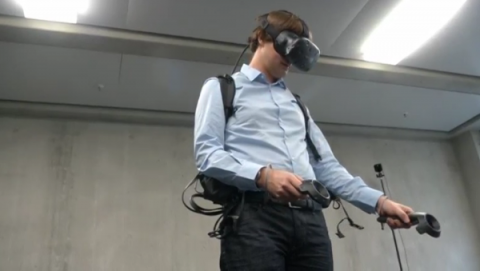
ZURICH, Switzerland (Reuters) — Designing a new building can be a laborious and costly task, and getting a clear idea of how the interior spaces will look can be tricky.
Swiss-based researchers founded the company Inspacion to remove this uncertainty with a virtual reality (VR) platform that allows users to step inside the design before it has been built.
They say it could be particularly useful when the layout of a room is vital to its functionality, such as in a hospital.
“Nowadays we have CAD (Computer Aided Design) designers that build the design, and then it’s disconnected from the people who work there,” said Inspacion co-founder Thomas Nescher.
“It’s very complex, having 2D plans and tonnes of pictures doesn’t tell us how it will really be to work there. But this is the most important question – how will it be to work in the space.”
Plans or 3D models are quickly imported into the Inspacion software and re-created as a full size 3D immersive virtual space. Wearing commercially available VR equipment, the user enters the virtual environment to design and plan the interior of the space from their own viewpoint.
This includes physically moving objects around into different positions to find the optimal layout.
The platform was developed at ETH Zurich by Nescher and colleagues Markus Zank and Janina Woods.
They have now formed a spin-off company to develop Inspacion as a cost-effective way for clients to efficiently plan their buildings.
Nescher said one particular space where planning foresight would be a distinct advantage is in hospitals and medical facilities.
Here, doctors have to be confident that all equipment and access routes are in the correct place.
“Nowadays this is done by building mock-ups, so cardboard mock-ups are used for doctors to test is because they really have to test the design, try to reach to the nurse, stretch out their arms, see how much space they have to understand if the design is good or not,” he said.
“We felt we can change this with virtual reality. They can now put on a head-mounted display and go into the operating room before it is finished and test it.”
Inspacion’s software gives doctors the ability to position every aspect of an operating theatre in the optimal place, including the direction of the lighting equipment.
“They can take a bed and put it there themselves in the virtual operating room. The can move it and check if it’s okay or not. They can add other devices if they want. And then they can, for instance, take the lamp and see if the lighting is okay for them to do an operation,” added Nescher.
Inspacion can also be used to plan and evaluate spaces in factories and other workplaces including public transport, where accessibility factors are important.
Shop designers can also use it to see how potential customers will interact with a space, including the positioning and layout of products.
Nescher added that Inspacion can be used by multiple designers at the same time, even if they’re on the other side of the world.
Users simply put on a VR headset and met up in the virtual space.
“The solution we are providing is collaborative, actually you can work together across the whole globe. Everyone can put on a head-mounted display no matter where they are, and they can meet inside a design and start working there together,” he said.








